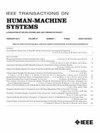一种不完善算法对活动踝关节外骨骼人体步态策略的影响
IF 4.4
3区 计算机科学
Q2 COMPUTER SCIENCE, ARTIFICIAL INTELLIGENCE
引用次数: 0
摘要
由于算法不完善,下肢主动外骨骼在操作设置中可能会出现错误,这可能会影响用户对系统的信任和人与外骨骼的流畅性(人与外骨骼之间的动作协调)。在这项研究中,我们在1.68%的步幅中引入了伪随机捕获试验(错误),其中预期的外骨骼扭矩没有应用于单个步幅,以了解对错过驱动的即时和时间依赖性响应。参与者(N = 15)在双侧动力踝关节外骨骼行走时完成了有针对性的行走任务。人类外骨骼的流畅性和信任度是从任务表现(步骤准确性)、步骤特征(步骤长度和宽度)、肌肉活动和下肢关节运动学推断出来的。在捕获试验中踝关节跖屈的减少表明用户适应外骨骼。髋关节屈曲和肌肉活动被调节,以减轻外骨骼扭矩损失的影响,并在捕捉试验中减少跖屈曲,以支持任务准确性和保持步骤特征。信任不会受到这种错误水平的影响,因为随着时间的推移,任务表现或步态特征没有显著差异。了解人类外骨骼流畅性、任务准确性和步态策略之间的相互作用将支持外骨骼控制器的开发。未来的工作将研究不同层次的驱动可靠性,以了解性能和信任受到影响的转变。本文章由计算机程序翻译,如有差异,请以英文原文为准。
Effect of an Imperfect Algorithm on Human Gait Strategies With an Active Ankle Exoskeleton
Lower-limb active exoskeletons may experience errors in operational settings due to imperfect algorithms, which may impact users' trust in the system and the human-exoskeleton fluency (the coordination of actions between the human and exoskeleton). In this study, we introduced pseudorandom catch trials (errors) in 1.68% of all strides, where an expected exoskeleton torque was not applied for a single stride, to understand the immediate and time-dependent responses to missed actuations. Participants (N = 15) completed a targeted stepping task while walking with a bilateral powered ankle exoskeleton. Human-exoskeleton fluency and trust were inferred from task performance (step accuracy), step characteristics (step length and width), muscle activity, and lower limb joint kinematics. Reductions in ankle plantarflexion during catch trials suggest user adaptation to the exoskeleton. Hip flexion and muscle activity were modulated to mitigate effects of the loss of exoskeleton torque and reduced plantarflexion during catch trials to support task accuracy and maintain step characteristics. Trust was not impacted by this level of error, as there were no significant differences in task performance or gait characteristics over time. Understanding the interactions between human-exoskeleton fluency, task accuracy, and gait strategies will support exoskeleton controller development. Future work will investigate various levels of actuation reliability to understand the transition where performance and trust are affected.
求助全文
通过发布文献求助,成功后即可免费获取论文全文。
去求助
来源期刊

IEEE Transactions on Human-Machine Systems
COMPUTER SCIENCE, ARTIFICIAL INTELLIGENCE-COMPUTER SCIENCE, CYBERNETICS
CiteScore
7.10
自引率
11.10%
发文量
136
期刊介绍:
The scope of the IEEE Transactions on Human-Machine Systems includes the fields of human machine systems. It covers human systems and human organizational interactions including cognitive ergonomics, system test and evaluation, and human information processing concerns in systems and organizations.
 求助内容:
求助内容: 应助结果提醒方式:
应助结果提醒方式:


